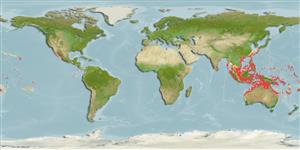Common names from other countries
>
Eupercaria/misc (Various families in series Eupercaria) >
Labridae (Wrasses) > Corinae
Etymology: Halichoeres: Greek, als, alis = salt + Greek, choiros = pig (Ref. 45335).
More on author: Randall.
Environment: milieu / climate zone / depth range / distribution range
Ecologie
marien rifbewoner; diepte 2 - 70 m (Ref. 90102), usually 15 - 60 m (Ref. 27115). Tropical; 24°C - 27°C (Ref. 27115); 32°N - 32°S
Eastern Indian Ocean: Christmas Island. Western Pacific: Solomon Islands, north to southern Japan, south to Rowley Shoals and New South Wales (Australia). Recently reported from Tonga (Ref. 53797). Replaced by Halichoeres leucoxanthus in the Indian Ocean, but with overlapping distributions in Indonesia (Ref. 37816).
Grootte / Gewicht / Leeftijd
Maturity: Lm ? range ? - ? cm
Max length : 12.0 cm TL mannelijk / geslacht onbekend; (Ref. 2334)
Dorsale stekels (totaal): 9; Dorsale zachte stralen (totaal): 12; Anale stekels 3; Anale zachte stralen: 11 - 12; Wervels: 25. In life, body bright yellow, head and thorax yellow-orange; a spot behind eye; head with irregular light-green bands. Dorsal fin of males with a large black, white-rimmed spot at the first interspinous membrane (another spot may appear on the soft portion between 2nd and 3rd rays for smaller males); females with a second black, light yellow-rimmed spot; smaller females and juveniles with a third blackish spot on penultimate membrane. Anterior lateral line scales with 2-4 pores; 6-12 suborbital pores. Pelvic fins not reaching anus.
Found at the reef edge, in sand and rubble areas (Ref. 9710) usually in small groups (Ref. 90102).
Levenscyclus en paargedrag
Maturiteit | Voortplanting | Paaien | Eieren | Fecunditeit | Larven
Distinct pairing during breeding (Ref. 205).
Randall, J.E., G.R. Allen and R.C. Steene, 1990. Fishes of the Great Barrier Reef and Coral Sea. University of Hawaii Press, Honolulu, Hawaii. 506 p. (Ref. 2334)
Status op de Rode Lijst van het IUCN (Ref. 130435)
CITES (Ref. 128078)
Not Evaluated
Gevaar voor de mens
Harmless
Gebruik door de mens
Aquarium: Commercieel
Meer informatie
ReferentiesAquacultuurAquacultuurprofielKweeklijnenGeneticaElectrophoresesErfelijkheidZiektesVerwerkingMassaconversie
Tools
Speciale rapporten
Download XML
Internetbronnen
Estimates based on models
Preferred temperature (Ref.
115969): 25.2 - 28.9, mean 27.7 (based on 662 cells).
Fylogenetische diversiteitsindex (Ref.
82804): PD
50 = 0.5000 [Uniqueness, from 0.5 = low to 2.0 = high].
Bayesian length-weight: a=0.00955 (0.00451 - 0.02020), b=3.09 (2.92 - 3.26), in cm Total Length, based on LWR estimates for this Genus-body shape (Ref.
93245).
Trofisch niveau (Ref.
69278): 3.4 ±0.5 se; based on size and trophs of closest relatives
Weerstandsvermogen (Ref.
120179): Hoog, minimale populatieverdubbelingstijd minder dan 15 maanden (Preliminary K or Fecundity.).
Fishing Vulnerability (Ref.
59153): Low vulnerability (10 of 100).
